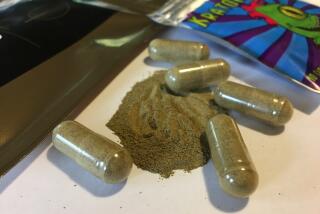‘Designer Drugs’ Tied to Parkinson’s Disease; Fear of Epidemic Told
- Share via
WASHINGTON — California may be facing an epidemic of Parkinson’s disease among young heroin addicts who used a synthetic drug two or more years ago and now are beginning to develop symptoms, the state’s chief drug abuse official says.
Robert J. Roberton told a Senate subcommittee last week that clinical experience indicates users of the drug known as MPTP can go for years before developing symptoms of Parkinson’s, in which the victim loses control of his body to paralysis, stiffness and uncontrollable tremors.
And while the problem for the moment appears confined to California, federal officials said they are trying to determine whether the toxic drug also is used in other parts of the country.
Roberton, testifying before the Senate labor and human resources subcommittee on drugs, said the problem began in 1982 when MPTP, a so-called “designer drug,” began circulating in Northern California.
MPTP is toxic to an area in the brain known as the substantia nigra , he said, the same area affected by Parkinson’s.
‘Frozen Up Overnight’
“We saw a group of young adults two years ago come to the Santa Clara Valley Medical Center who resembled in every way elderly patients with end-stage Parkinson’s disease,” he said. “These young addicts had literally frozen up overnight, and were totally unable to move or talk.
“Treatment with anti-Parkinsonian therapy was probably life-saving in three,” he said. “However, these patients continue to be severely disabled and required medication every one to three hours just to be able to move and eat or drink. The outlook for their futures must be considered grim indeed.”
Only 20 people have been permanently crippled so far, Roberton said, but he added that that is probably just a beginning.
“We now have evidence that damage to this area of the brain, even if it is not enough to cause symptoms at first, may act like a time bomb, with changes in the brain slowly ticking away,” he said.
‘Myriad of Symptoms
“Up until now, this concern was just theoretical,” he said. “But in the last several months, we have started seeing a group of young people at (the center) who used MPTP two years ago who are now starting to develop a myriad of symptoms, all suggestive of early Parkinson’s disease.”
He said California officials have identified more than 500 people who were exposed to MPTP thinking it was a new synthetic heroin. And he said drug officials believe there are at least 100 to 200 more who have not been identified.
“In short, what we may be facing is an epidemic of Parkinson’s disease in young adults in Northern California as a result of this catastrophe,” Roberton said. “The cost to society, not to mention the human suffering, could be immense.”
Donald Ian MacDonald, head of the federal Alcohol Drug Abuse and Mental Health Administration, said his agency is attempting to determine whether the problem has spread to other states.
Series of Hearings
The testimony came in the latest of a series of congressional hearings on designer drugs, variants of illegal drugs that are produced by underground chemists to escape the reach of criminal statutes.
The name “designer drugs” was first coined as a backhanded compliment to the skills of chemists who can virtually design a drug to order.
Operating out of basement laboratories with common chemicals, they turn out potent narcotics and hallucinogens that, because of a slightly altered chemical structure, fall outside criminal law--but can have as bad or worse effects than the drug that is outlawed.
John C. Lawn, head of the Drug Enforcement Administration, said new laws are needed to confront the problem because chemists can come up with new drugs faster than they can be outlawed under the current statutes.
“The nature of this phenomenon is such that the traffickers can and are circumventing our efforts by creating new uncontrolled analogs of controlled drugs,” he told the subcommittee. “Without additional legislation, we will continually be one step behind many of these drug traffickers.”
More to Read
Sign up for Essential California
The most important California stories and recommendations in your inbox every morning.
You may occasionally receive promotional content from the Los Angeles Times.













